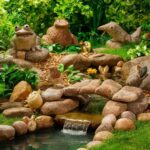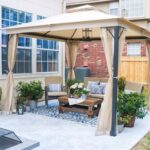Imagine planning your garden beds. Every choice, from the materials you use to the shapes you create, can make a big difference.
Picture how the sunlight hits your plants and how they all fit together perfectly. But there’s even more to explore! You can add cool design features and try out new ideas to make your garden beds stand out.
Key Takeaways
Use stone, square, rectangular, and circular shapes for beds. Adjust height for plant needs. Add tiers, corners, and trellises. Place strategically for sunlight, drainage, access, and plant requirements.
Selecting Suitable Garden Bed Materials
When choosing materials for your garden bed, consider using stone for a durable and stylish option. Stone beds have a rustic and elegant look that can add sophistication to your garden. Stones are long-lasting and blend well with different garden styles, from traditional to modern.
Adding stone to your garden bed design can enhance the overall appearance of your outdoor space. Stones provide a strong base for your plants and give a visually appealing touch to your garden. Whether you choose natural stone or prefabricated stone blocks, this material will bring a timeless charm to your raised beds.
Using stone for your garden beds can create a durable and visually stunning focal point in your garden design.
Exploring Various Garden Bed Shapes
When planning your garden layout, consider different bed shapes to enhance the look and functionality of your outdoor space. Here are some popular garden bed shapes to inspire you:
- Square Beds: These beds are efficient for planting and easy to navigate around. They give your garden a tidy and organized appearance while maximizing planting space.
- Rectangular Beds: Versatile and suitable for different areas, rectangular beds offer design flexibility. They work well for structured layouts and can be adjusted to fit various garden sizes.
- Circular Beds: Circular beds create a focal point in the garden, adding visual interest. Planting flowers in the center can boost curb appeal and create a stunning garden centerpiece.
Adjusting Garden Bed Heights for Plants
Adjust the height of your garden beds based on the plants you want to grow. For deep-rooted crops like carrots, use tall raised beds that are 18–24 inches high.
If you prefer standing while gardening, go for raised beds over 36 inches. Low-raised beds, 6–8 inches tall, are good for shallow-rooted plants like lettuce and herbs.
Adjustable-height raised beds give you flexibility to match your plants’ needs. Choosing the right height ensures your plants have room to grow and get the nutrients they need to thrive.
Enhancing Garden Beds With Design Features
Enhance your garden beds with tiered beds, corner beds, and trellis or arbor beds.
Tiered beds have multiple levels for planting different plants, corner beds use unused spaces efficiently, and trellises provide vertical growing space.
These features maximize space and add visual interest to your garden.
Placing Garden Beds in Ideal Locations
Position your garden beds where they get 6 to 8 hours of sunlight daily for most flowers and vegetables to thrive.
If you plan to grow shade-loving plants, put them in beds where they get filtered sunlight or shade during the day.
Make sure the garden beds have good drainage to prevent waterlogging and root rot. Consider adding drainage holes if needed.
Place the beds near the house for easy access to water, harvest, and maintenance.
Designing Raised Beds for Planting
When making raised beds for planting, consider the following factors:
- soil depth should be sufficient for root growth.
- Bed size should be easily reachable for planting.
- Water drainage is crucial to avoid water buildup.
These considerations will promote optimal growth for your plants in the raised beds.
Soil Depth Considerations
When making raised beds for planting, remember these soil depth guidelines:
- Most plants do well in 6–12 inches of soil.
- Carrots need 18–24 inches of soil.
- Lettuce thrives in 6–8 inches of soil.
Optimal Bed Dimensions
When building your raised garden bed, go for a standard rectangular shape that’s 3–4 feet wide and 6–8 feet long. This size provides enough space for your plants to grow well and makes it easy for you to reach them without compacting the soil.
Longer beds give you more room to grow a variety of plants and vegetables. Choosing the right dimensions for your raised bed depends on the space you have, the types of plants you want to grow, and how easily you want to access your garden for maintenance.
Drainage and Irrigation
To keep your plants healthy in raised beds, you need to make sure water doesn’t get stuck. Here’s what you can do:
- Drainage Holes: Put holes in the bottom of your raised beds so water can flow out and plants won’t drown.
- Gravel or Rocks: Add gravel or rocks at the bottom to help water drain better and stop it from pooling.
- Irrigation Systems: Use soaker hoses or drip irrigation to water your plants just the right amount and keep them happy.
Innovative Raised Bed Designs
When you’re looking for cool raised bed designs, you’ll come across different options to spruce up your garden. Try hexagonal beds for a unique look that stands out.
The Big Orange raised bed has a tough corrugated steel design that’s strong and easy to move. If you want something artsy, mosaic-patterned raised beds use old wood pieces arranged creatively.
For a cozy touch, raised beds with benches offer seating and keep pests away. Live-edge raised beds have a natural, rustic look with the wood’s raw edge preserved.
These designs make gardening more fun and add charm to your outdoor space.
Building Flower Beds for Curb Appeal
If you want your garden to look really nice, plant flowers that bloom at different times so you always have color.
Choose plants that don’t need a lot of care and match the weather where you live. Mix up the colors and shapes of the plants to make your garden interesting.
Keep your flower beds tidy by pulling out weeds, removing dead flowers, and watering them when needed. Doing this will make sure your plants stay healthy and attract pretty insects like bees and butterflies.
Frequently Asked Questions
How Can I Make My Garden Bed Look Nicer?
To make your garden bed look nicer, mix flowers and plants with different colors and textures. Layer them for a full look, add eye-catching plants, and think about changing things up for each season. Use rocks or mulch to give your garden a neat finish. Your garden will look amazing!
How Do I Make My Garden Aesthetically Pleasing?
To make your garden look nice, focus on using different colors, planting in containers, creating pathways, growing plants vertically, adding focal points like statues, and changing decorations with the seasons. Use bright flowers, pretty pots, curvy paths, climbing structures, and eye-catching statues, and switch up decorations for different times of the year.
How Do I Make My Garden Classy?
To make your garden classy, focus on elegant design, timeless charm, sophisticated style, chic elements, luxurious touches, and classy appeal. Use high-quality materials like marble, wrought iron, and wood. Choose harmonious colors, like soft pastels or rich neutrals. Keep your plants well-maintained with regular watering and pruning for a refined and upscale look.
How Can I Make My Vegetable Garden Attractive?
To make your vegetable garden attractive, use colorful containers, trellises for climbing plants, decorative edging for borders, ornamental herbs for charm, signage for a personal touch, and seating for a cozy spot.
Conclusion
To create beautiful garden beds, you need to choose the right plants, materials, shapes, and heights. Add design features and place them in ideal spots. This way, your garden will look great, and your plants will grow well.
Try different styles and arrangements to make your outdoor space unique and stunning. Enjoy gardening!











